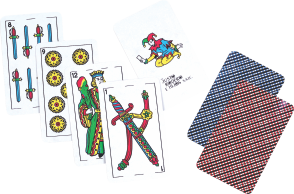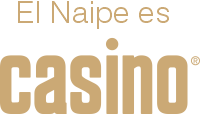
General Rules
The “escoba de 15” is one of the more popular games. A pack of 40 cards is used, having the jacks a value of 8, the queens 9 and the kings 10. The rest of the cards have the value their number expresses.
In the “escoba “the seven of gold is a valuable card that represents one point for whom has received it in a trick.
The players can be two or more, if their are four, two can be companions against the other two.
One of the players suffles the cards, gives the to cut to his neighbor at his left, and then deals the cards once at a time to each one of the players, including himself, until each one has three cards. Then he deals four cards face up, that remain in the center of the table.
The one who is hand starts to play (the player sitting to the right of the dealer).
The game consists in forming the quantity 15 counting the value of some of the cards that are in hand and of one or more of those laying face up on the table. For example, if a player has in his hand a queen, with it he will be able to take a six from the table, (if there is one), or a four and a two, or a five and and an ace, etc. That is, that with one of his cards and another or others from the table, he has to form the number 15.
If when forming the combination of 15 the player does not leave any card on the table, he has made an “escoba”. For example: In the table there is a three, a two and two aces, (that add up 7); with one jack (worth 8), the player picks up all the cards making an “escoba”. The cards that form the trick he puts them close to him, face down and turns one of them face up, so as to mark with it the “escoba” that will represent one point in the final adding up of them.
If one player has made an “escoba”, the player following him will only be able to play one of his cards, without, naturally, being able to do a trick. In these cases, one tries always to play a card of low value (a four as a maximum) because this won´t allow the next player to do a trick.
When, following the turn, the players remain without cards in their hands, the one who dealt deals three cards to each one (but without laying none face up on the table), an this continues until finishing the cards of the “monte” or “baceta”; once played the last hand, each player will have with him his tricks and and then proceeds to count the points obtained, which are jotted down, and the the game is renewed, the dealer being the one that was hand in the previous game. It is normally played up to a score of 15.
Summing up of points
In the “escoba,” the cards, the golds, the “setentas” and the seven of gold, are valuable for the scoring, as seen below:
The Cards
The player will jot down a point, whose tricks have totalizad the biggest quantity of cards.
The Golds
Whoever has in his tricks the bigger quantity of cards of this suit will jot down a point.
The Setentas
The winner of the “setenta” and with them one point, is the one that with the cards of his tricks can gather the four that represent the higher value, having to be each one of different suit. For this estimation, the figures (jacks, queens and kings) are only valid for their suit, without adding value to the points. In this way, the winning “setentas” would be formed by the four sevens (value 28), followed in importance by the one formed by the three sevens and a six (all of different suit), with a value of 27. The “setentas” formed, for example, with the six of spades, the two of gold, the ace of clubs and the jack of hearts, only reach a value of 9.
The Seven of Gold
The sole possession of this card in the tricks done is worth a point,
The Escobas
Each one of the “escobas” that a player has done is worth a point.
